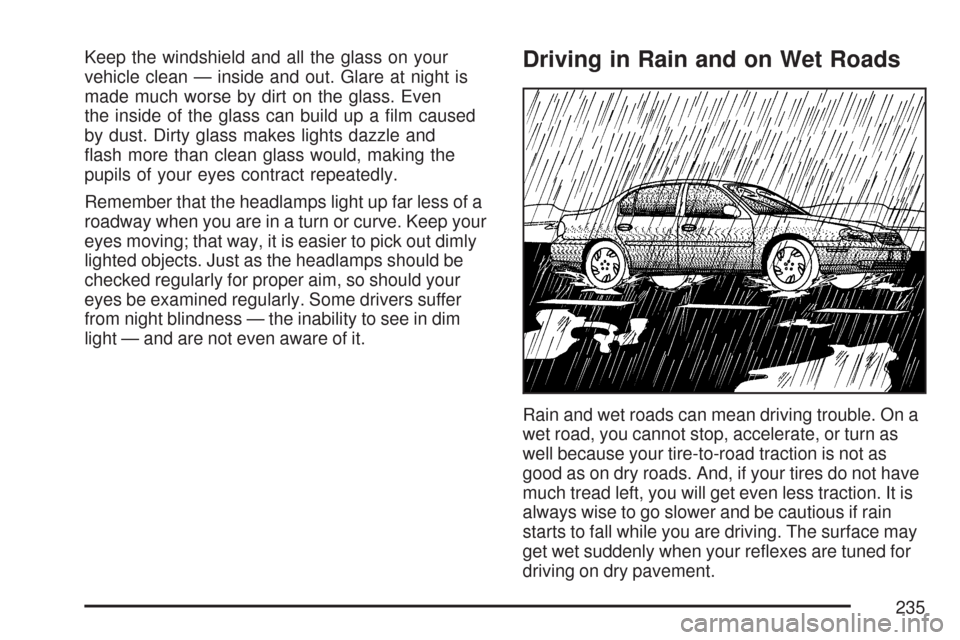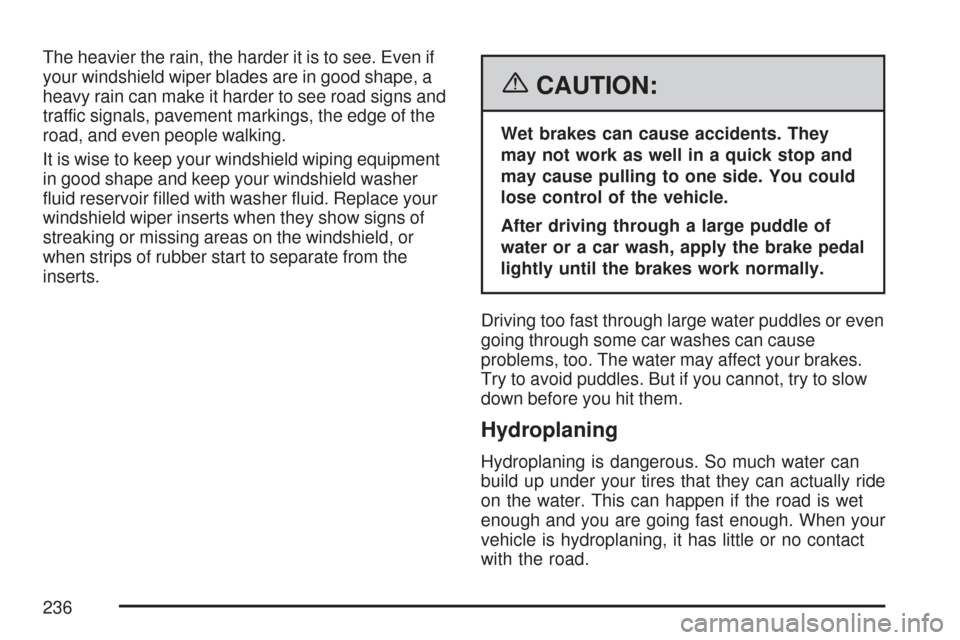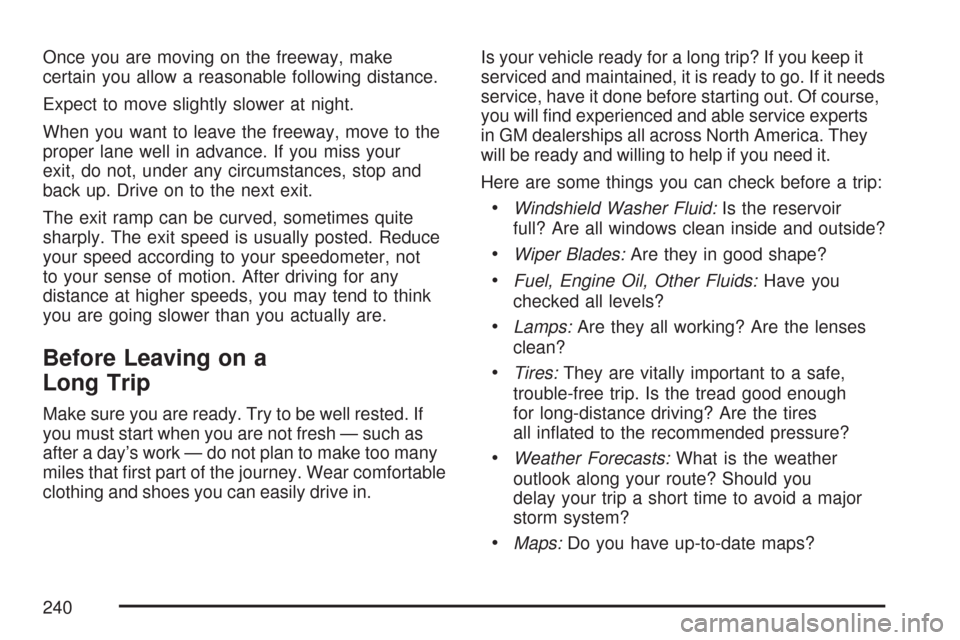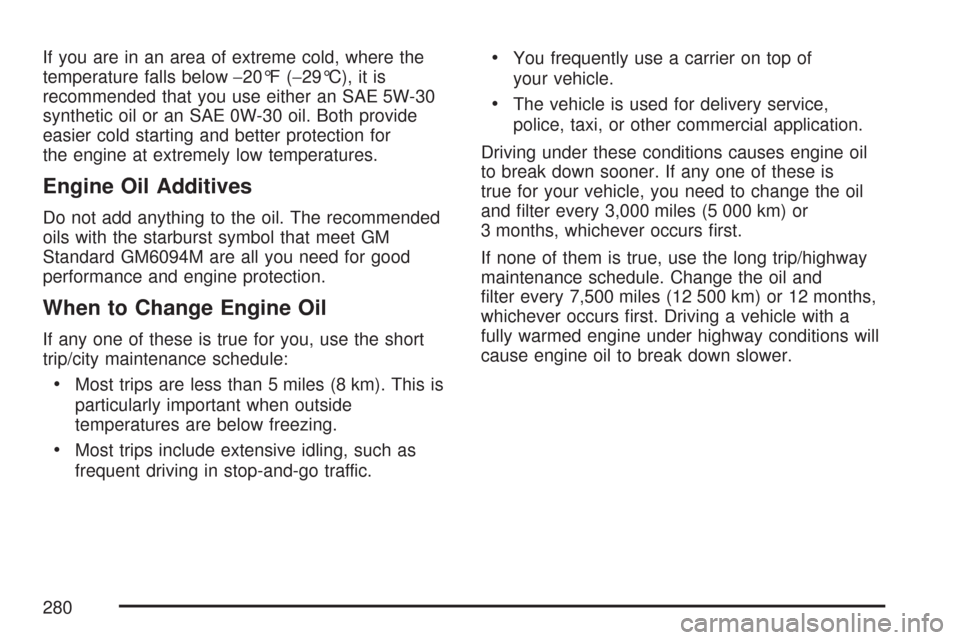Page 235 of 436

Keep the windshield and all the glass on your
vehicle clean — inside and out. Glare at night is
made much worse by dirt on the glass. Even
the inside of the glass can build up a film caused
by dust. Dirty glass makes lights dazzle and
flash more than clean glass would, making the
pupils of your eyes contract repeatedly.
Remember that the headlamps light up far less of a
roadway when you are in a turn or curve. Keep your
eyes moving; that way, it is easier to pick out dimly
lighted objects. Just as the headlamps should be
checked regularly for proper aim, so should your
eyes be examined regularly. Some drivers suffer
from night blindness — the inability to see in dim
light — and are not even aware of it.Driving in Rain and on Wet Roads
Rain and wet roads can mean driving trouble. On a
wet road, you cannot stop, accelerate, or turn as
well because your tire-to-road traction is not as
good as on dry roads. And, if your tires do not have
much tread left, you will get even less traction. It is
always wise to go slower and be cautious if rain
starts to fall while you are driving. The surface may
get wet suddenly when your reflexes are tuned for
driving on dry pavement.
235
Page 236 of 436

The heavier the rain, the harder it is to see. Even if
your windshield wiper blades are in good shape, a
heavy rain can make it harder to see road signs and
traffic signals, pavement markings, the edge of the
road, and even people walking.
It is wise to keep your windshield wiping equipment
in good shape and keep your windshield washer
fluid reservoir filled with washer fluid. Replace your
windshield wiper inserts when they show signs of
streaking or missing areas on the windshield, or
when strips of rubber start to separate from the
inserts.
{CAUTION:
Wet brakes can cause accidents. They
may not work as well in a quick stop and
may cause pulling to one side. You could
lose control of the vehicle.
After driving through a large puddle of
water or a car wash, apply the brake pedal
lightly until the brakes work normally.
Driving too fast through large water puddles or even
going through some car washes can cause
problems, too. The water may affect your brakes.
Try to avoid puddles. But if you cannot, try to slow
down before you hit them.
Hydroplaning
Hydroplaning is dangerous. So much water can
build up under your tires that they can actually ride
on the water. This can happen if the road is wet
enough and you are going fast enough. When your
vehicle is hydroplaning, it has little or no contact
with the road.
236
Page 240 of 436

Once you are moving on the freeway, make
certain you allow a reasonable following distance.
Expect to move slightly slower at night.
When you want to leave the freeway, move to the
proper lane well in advance. If you miss your
exit, do not, under any circumstances, stop and
back up. Drive on to the next exit.
The exit ramp can be curved, sometimes quite
sharply. The exit speed is usually posted. Reduce
your speed according to your speedometer, not
to your sense of motion. After driving for any
distance at higher speeds, you may tend to think
you are going slower than you actually are.
Before Leaving on a
Long Trip
Make sure you are ready. Try to be well rested. If
you must start when you are not fresh — such as
after a day’s work — do not plan to make too many
miles that first part of the journey. Wear comfortable
clothing and shoes you can easily drive in.Is your vehicle ready for a long trip? If you keep it
serviced and maintained, it is ready to go. If it needs
service, have it done before starting out. Of course,
you will find experienced and able service experts
in GM dealerships all across North America. They
will be ready and willing to help if you need it.
Here are some things you can check before a trip:
•Windshield Washer Fluid:Is the reservoir
full? Are all windows clean inside and outside?
•Wiper Blades:Are they in good shape?
•Fuel, Engine Oil, Other Fluids:Have you
checked all levels?
•Lamps:Are they all working? Are the lenses
clean?
•Tires:They are vitally important to a safe,
trouble-free trip. Is the tread good enough
for long-distance driving? Are the tires
all inflated to the recommended pressure?
•Weather Forecasts:What is the weather
outlook along your route? Should you
delay your trip a short time to avoid a major
storm system?
•Maps:Do you have up-to-date maps?
240
Page 280 of 436

If you are in an area of extreme cold, where the
temperature falls below−20°F (−29°C), it is
recommended that you use either an SAE 5W-30
synthetic oil or an SAE 0W-30 oil. Both provide
easier cold starting and better protection for
the engine at extremely low temperatures.
Engine Oil Additives
Do not add anything to the oil. The recommended
oils with the starburst symbol that meet GM
Standard GM6094M are all you need for good
performance and engine protection.
When to Change Engine Oil
If any one of these is true for you, use the short
trip/city maintenance schedule:
•Most trips are less than 5 miles (8 km). This is
particularly important when outside
temperatures are below freezing.
•Most trips include extensive idling, such as
frequent driving in stop-and-go traffic.
•You frequently use a carrier on top of
your vehicle.
•The vehicle is used for delivery service,
police, taxi, or other commercial application.
Driving under these conditions causes engine oil
to break down sooner. If any one of these is
true for your vehicle, you need to change the oil
and filter every 3,000 miles (5 000 km) or
3 months, whichever occurs first.
If none of them is true, use the long trip/highway
maintenance schedule. Change the oil and
filter every 7,500 miles (12 500 km) or 12 months,
whichever occurs first. Driving a vehicle with a
fully warmed engine under highway conditions will
cause engine oil to break down slower.
280
Page 434 of 436

Service (cont.)
California Proposition 65 Warning............. 265
Doing Your Own Work............................. 265
Engine Soon Light...........................166, 180
Publications Ordering Information............. 420
Servicing Your Airbag-Equipped Vehicle......... 82
Sheet Metal Damage................................... 351
Shifting Into Park (P)................................... 118
Shifting Out of Park (P)............................... 120
Short Trip/City Scheduled Maintenance........ 376
Shoulder Belt Height Adjuster........................ 33
Signals, Turn and Lane-Change.................. 138
Spare Tire
Compact.................................................. 344
Installing.................................................. 339
Removing................................................ 337
Storing..................................................... 344
Specifications, Capacities............................ 368
Speedometer............................................... 159
Starting Your Engine................................... 109
Steering...................................................... 228
Steering, Suspension and Front Drive
Axle Boot and Seal Inspection................. 394
Steering Wheel Controls, Audio................... 215
Steering Wheel, Tilt Wheel.......................... 136Storage Areas............................................. 126
Cupholder(s)............................................ 127
Glove Box................................................ 127
Sunglasses Storage Compartment............ 127
Stuck in Sand, Mud, Ice, or Snow............... 248
Sun Visors.................................................. 103
Sunroof....................................................... 128
T
Tachometer................................................. 159
Taillamps
Turn Signal, Stoplamps and Back-up
Lamps.................................................. 316
Theft-Deterrent System................................ 103
Theft-Deterrent Systems.............................. 103
Immobilizer.............................................. 106
Immobilizer Operation.............................. 106
Tilt Wheel.................................................... 136
Time ........................................................... 149
Tires........................................................... 319
Aluminum Wheels, Cleaning..................... 350
Buying New Tires..................................... 330
Chains..................................................... 335
Changing a Flat Tire................................ 336
434